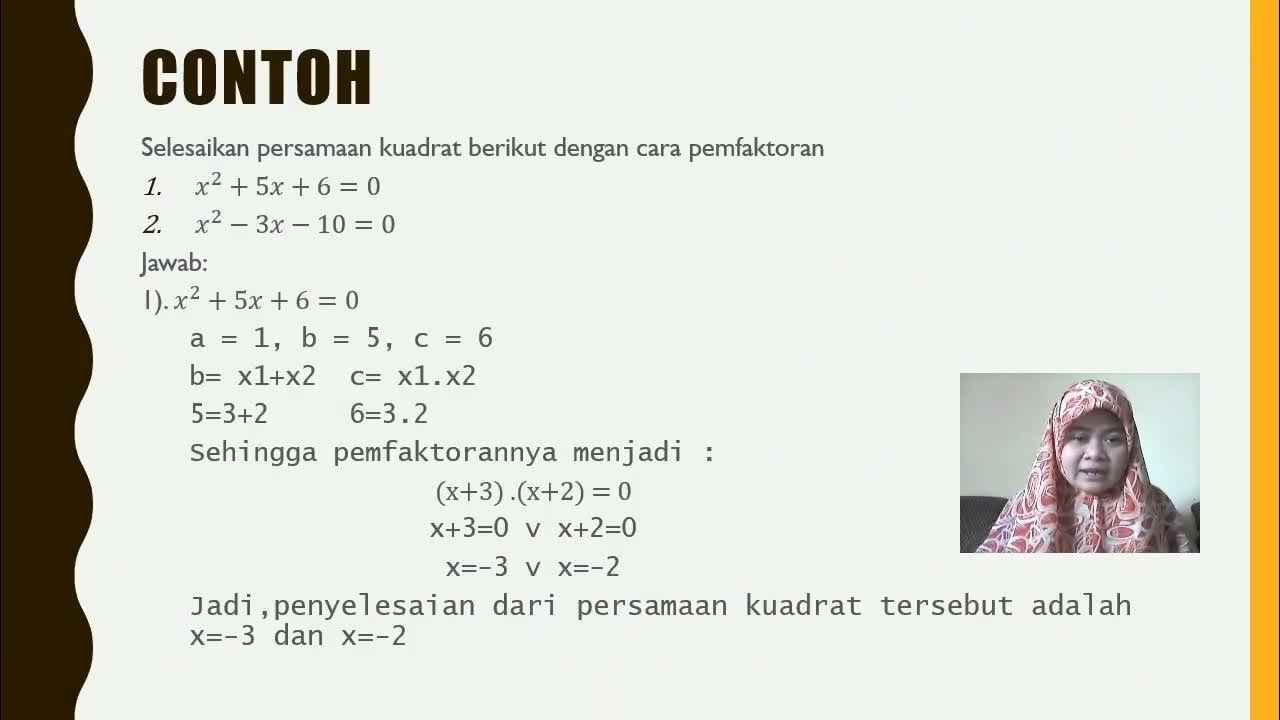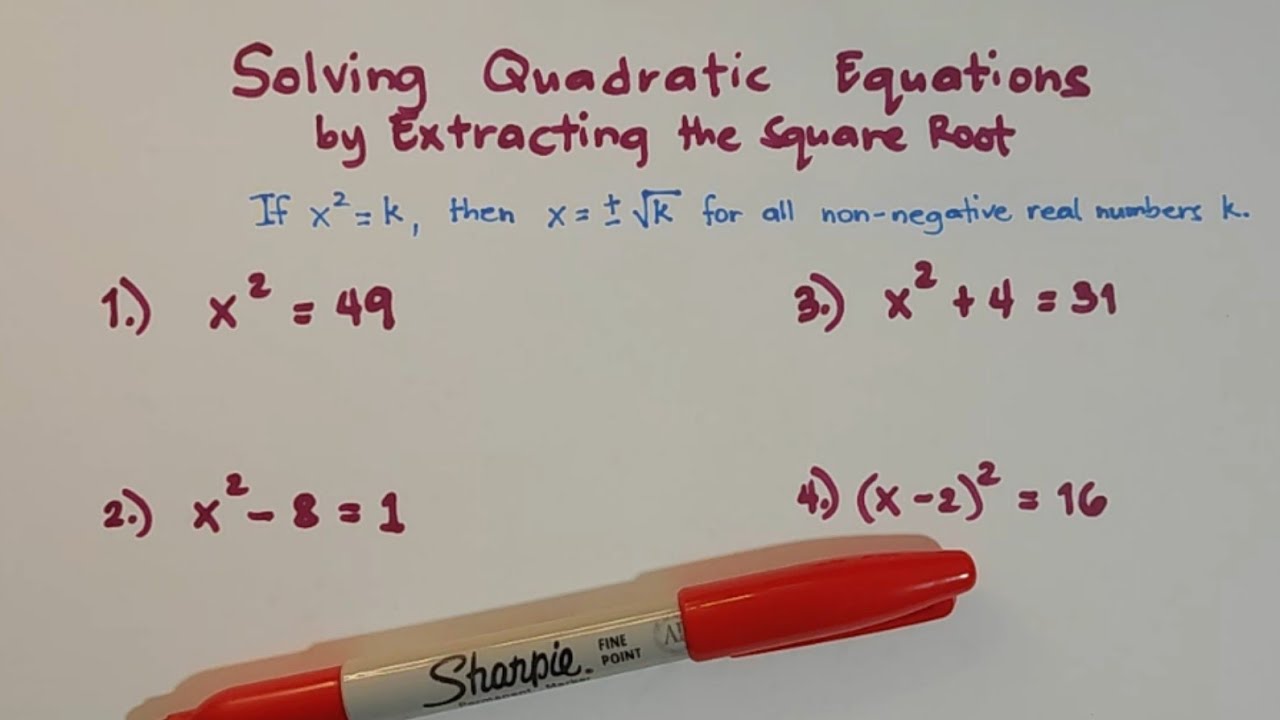Uji Pemahaman hal 191 no 2 Matematika Kelas 10
Summary
TLDRIn this video, the instructor provides a detailed step-by-step guide to solving quadratic equations using factoring methods. The video covers a range of examples, from simple to more complex equations, demonstrating how to find two numbers that multiply to a given constant and add to a specific coefficient. Key topics include factoring techniques, applying the zero-product property, and solving various quadratic equations with different forms. The content is ideal for students looking to improve their understanding of quadratic equations and factoring methods.
Takeaways
- 😀 The video continues a lesson on solving quadratic equations using factorization, following up on a previous video explaining the basics of factorization.
- 😀 Factorization involves finding two numbers that multiply to give the constant term and add up to give the coefficient of the linear term.
- 😀 In part A, the equation x² - 3x - 28 = 0 is factored as (x - 7)(x + 4) to find solutions x = 7 and x = -4.
- 😀 In part B, the equation x² - 5x - 14 = 0 is factored as (x - 7)(x + 2) to find solutions x = 7 and x = -2.
- 😀 In part C, the equation x² - 9x + 20 = 0 is factored as (x - 5)(x - 4) to find solutions x = 5 and x = 4.
- 😀 In part D, the equation x² - 10x + 24 = 0 is factored as (x - 6)(x - 4) to find solutions x = 6 and x = 4.
- 😀 In part E, the equation x² - 18x - 32 = 0 is factored as (x - 16)(x - 2) to find solutions x = 16 and x = 2.
- 😀 In part F, the equation x² - 19x + 48 = 0 is factored as (x - 16)(x - 3) to find solutions x = 16 and x = 3.
- 😀 For equations like 4x² - 13x - 12 = 0 in part G, the factoring process involves simplifying and finding factors of the constant and linear terms.
- 😀 The video covers a variety of quadratic equations, demonstrating different approaches to factorization and solution-finding, including when there are higher degree terms or no constant terms.
Q & A
What is the main focus of this video?
-The main focus of this video is on solving quadratic equations using factoring techniques, with detailed examples provided throughout.
What are the steps involved in factoring quadratic equations?
-To factor quadratic equations, one needs to find two numbers that multiply to the constant term and add to the coefficient of the linear term. These numbers help to break the middle term and simplify the equation.
What is the first example problem given in the video?
-The first example problem is solving the quadratic equation x² - 3x - 28 = 0 by factoring.
How do you factor the equation x² - 3x - 28 = 0?
-To factor x² - 3x - 28 = 0, we look for two numbers that multiply to -28 and add to -3. These numbers are -7 and +4, so the factored form is (x - 7)(x + 4) = 0.
What is the solution for x in the equation x² - 3x - 28 = 0?
-The solutions for x are x = 7 and x = -4, as we set each factor equal to zero.
How is the equation x² - 5x - 14 = 0 factored?
-To factor x² - 5x - 14 = 0, we find two numbers that multiply to -14 and add to -5. These numbers are -7 and +2, so the factored form is (x - 7)(x + 2) = 0.
What happens if a quadratic equation does not factor easily?
-If a quadratic equation does not factor easily, alternative methods such as completing the square or using the quadratic formula can be used to solve it.
What technique is used to solve the equation 45x² - 80 = 0?
-To solve 45x² - 80 = 0, we first divide the entire equation by 5, simplifying it to 9x² - 16 = 0. Then, we recognize it as a difference of squares and factor it into (3x + 4)(3x - 4) = 0.
How do you factor the equation 4x² - 81 = 0?
-To factor 4x² - 81 = 0, we recognize it as a difference of squares, since 4x² = (2x)² and 81 = 9². The factored form is (2x + 9)(2x - 9) = 0.
What does it mean if an equation is a 'difference of squares'?
-A 'difference of squares' is an equation that can be written as the difference between two perfect squares, which can be factored as (a + b)(a - b) = 0.
Outlines

This section is available to paid users only. Please upgrade to access this part.
Upgrade NowMindmap

This section is available to paid users only. Please upgrade to access this part.
Upgrade NowKeywords

This section is available to paid users only. Please upgrade to access this part.
Upgrade NowHighlights

This section is available to paid users only. Please upgrade to access this part.
Upgrade NowTranscripts

This section is available to paid users only. Please upgrade to access this part.
Upgrade NowBrowse More Related Video

Persamaan Kuadrat part 1

SOLVING QUADRATIC EQUATIONS USING QUADRATIC FORMULA | Grade 9 Learning Task 3 Week 1

Penting dan Wajib Bisa - Cara Memfaktorkan Bentuk Kuadrat

Solving Rational Equations

How to Solve Quadratic Equations by Extracting the Square Root? @MathTeacherGon

Persamaan Kuadrat Kelas 10 Kurikulum Merdeka
5.0 / 5 (0 votes)